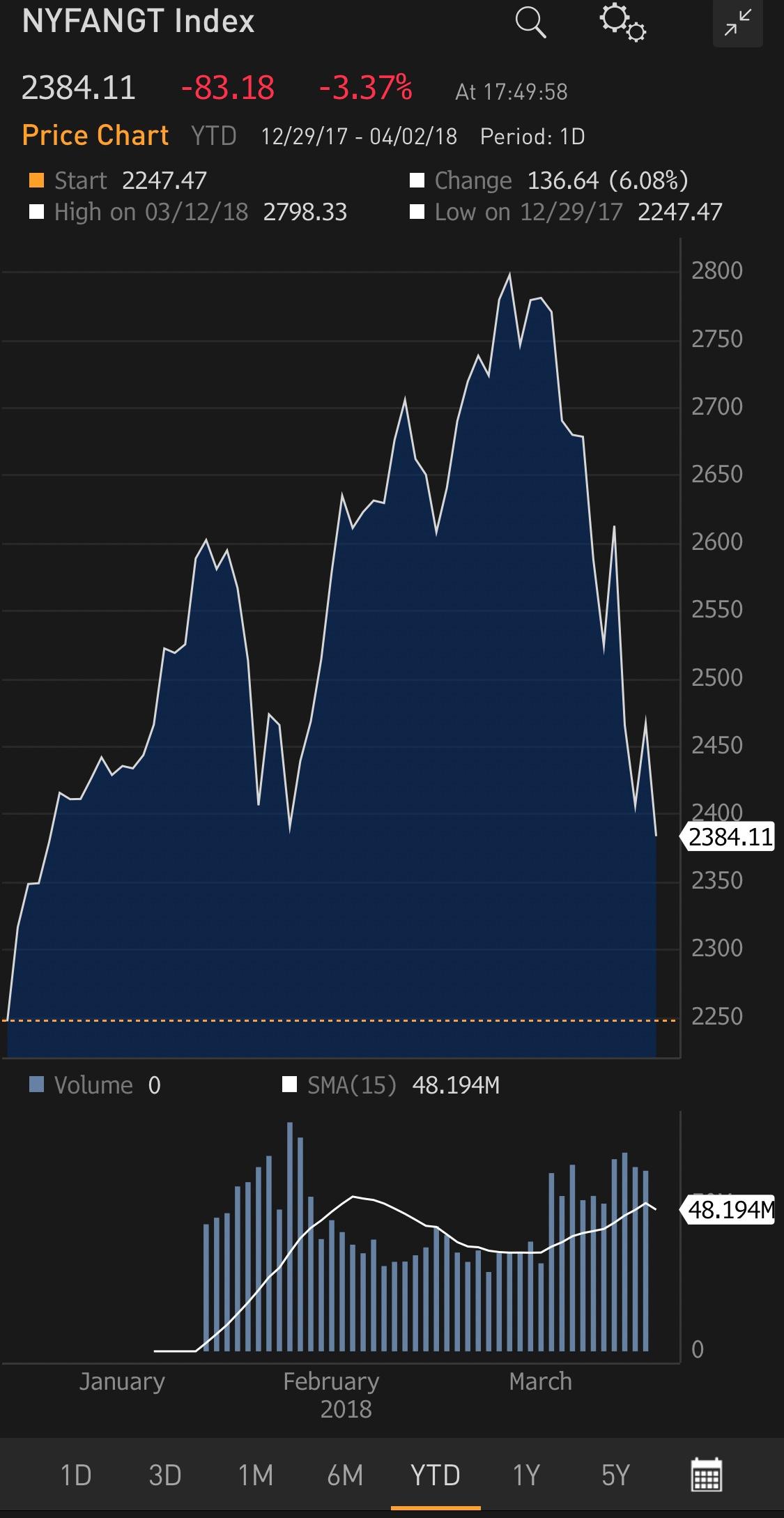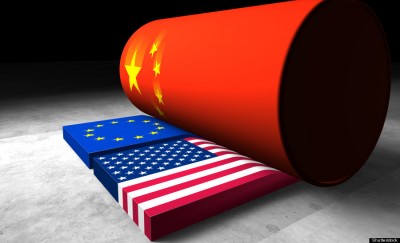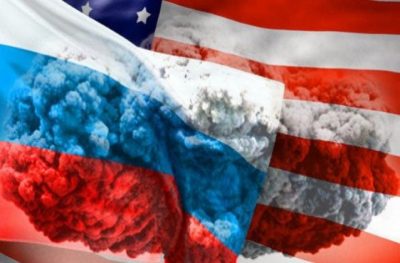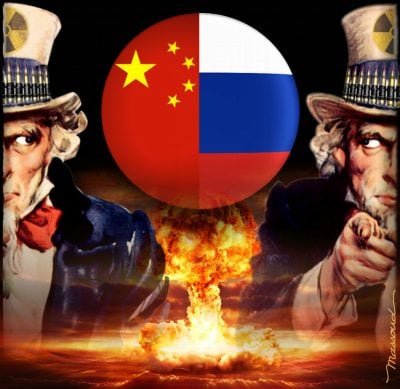|
Why the Nuclear War Is No Longer Unthinkable?
|
By Maxim Nikolenko
Global Research, April 02, 2018
|
Url of this article:
https://www.globalresearch.ca/why-the-nuclear-war-is-no-longer-unthinkable/5634383
|
Just a few weeks before his reelection, President Vladimir Putin delivered a speech
to the members of the Federal Assembly, setting an agenda for the
country’s military and economic development. Internationally, this
annual event has gained attention as Russia, apart from other things,
announced the enhancement of its nuclear delivery systems. In total, the
development of six new delivery systems was announced, with videos
demonstrating their strike capabilities. The Kremlin’s show of force was
vividly aimed at the international audience, precisely, the powers of
the North Atlantic Treaty Organization (NATO).
The response to Putin’s address was immediate.
“We don’t regard it as the behavior of a responsible international player,” commented the U.S. State Department spokesperson, Heather Nauert.
With that note, she was referring to the video animation showcasing
Russia’s new intercontinental ballistic missile system called Sarmat.
President Putin announced this missile as “a very powerful mighty
weapon.” A missile with almost indefinite endurance means “nothing, not
even perspective” anti-ballistic missile systems “could be an obstacle
for it.” Consequently, this will, according to Putin, restore the
balance of power between Washington and Moscow. “Nobody wanted to listen
to us” on the matter, he stressed. “Well, listen to us now.”
The theme of Russia being an irresponsible international player was
reiterated across the conventional corporate media apparatuses.
Washington is, again, talking about the Cold War.
Accordingly, Putin’s address must be taken as a challenge to the U.S,
requiring it to make a strong response. “Oddly,” therefore, “Mr. Trump
has said almost nothing about the new era of competition with Mr. Putin
or Russia,” reported the New York Times
on March 1. The presentation of Sarmat cruise missiles “sharply
escalated the military invective in the tense relationship between” the
two nuclear powers. Reporting
on the same day, the liberal American news outlet Vox stated that if
Russia has the weapons it demonstrated, then it “purposefully raised the
stakes in the decades-long nuclear standoff.” The Washington Post, in
the meantime, went to amplify
the rhetoric of American’s most aggressive foreign policy strategists:
“U.S. defense officials have consistently cited Russia as the most
significant strategic threat to the United States, and the primary
reason to build up its defense budget.”
Indeed, the enhancement of Russia’s missile capabilities should be taken as a worrying development.
If one looks at this development objectively, however, and, is
concerned about the “strategic” security of people, including those
living in the U.S, then they would inevitably spot the United States to
be the biggest threat to international security, with its “defense
budget” feeding the new power rivalry.
The Balance of Power
Conspicuously, warmongering Western media outlets have failed to
report the most important point of Putin’s remarks about his
government’s defense policy.
“Our military doctrine,” he stated, “says Russia reserves
the right to use nuclear weapons solely in response to a nuclear
attack, or an attack with other weapons of mass destruction against the
country or its allies, or an act of aggression against us with the use
of conventional weapons that threaten the very existence of the state.”
The reason for the enhancement of the nuclear delivery systems was
stated, too. In fact, the statement replicated what the President has
already said on numerous occasions. The audience in America, for
example, had had an opportunity to learn about Russia’s geopolitical
agenda in 2017 from a series of documentary films called The Putin Interviews. They were produced by an American filmmaker, Oliver Stone.
There, Putin criticized Washington for unilaterally withdrawing from
the Anti-Ballistic Missile Treaty in 2002, a framework established to
maintain a balance of power between Washington and Moscow during the
Cold War. To put it in Putin’s words, the treaty “was the cornerstone of
the system of the international security,” as it limited the number of
locations where the two powers could place their anti-ballistic missile
systems, installed for defending one side from an incoming nuclear
missile attack from the other. Ignoring the fact that both powers have
acquired enough nuclear arms to annihilate both each other and the rest
of mankind, the treaty provided a framework under which the balance of
power between the two sides was measurable. The threat of nuclear war
was consequently reduced.
In an environment where the Anti-Ballistic Missile Treaty is no
longer in place, Putin stated that “to preserve the crucial element of
international security and stability, mainly the strategic balance of
power, we would be obliged to develop our offensive capabilities.” This
implies the development of the “missiles capable of surmounting any
anti-ballistic missile system.”
The “crucial element of international security and stability” has
been jeopardized by NATO, or the expansion of the military alliance and
its forces into Eastern Europe. Incorporating countries of the former
socialist block, the alliance not only maintains a military presence in
states such as Romania, Poland and Latvia but uses the power vacuum
created from the absence of a missile treaty to install its
anti-ballistic missile systems near the Russian border. President Putin
has outlined the danger such a trend poses to Russia quite
instructively. Admittedly, the first threat is the placement of
“anti-ballistic missiles in the vicinity of our [Russian] border.” The
second threat arises from the fact that “the launching pods of these
anti-ballistic missiles can be transformed, within a few hours, into
offensive missile launching pods.”
For bringing the Putin Interviews to the American audience, Oliver
Stone was condemned as an apologist for the Kremlin. On the matter, it
is worth quoting an article
from the Foreign Policy, a reputable news publication. While dismissing
the interviews for telling “little about Putin and even less about
Russia,” the piece was alarmed that the series amplifies “the Kremlin
line”, which, of course, consists of “conspiracy theories.”
Iranian Threat in Europe
Perhaps, we should ignore Putin’s “conspiracy theories” and use
Western sources to test whether his concerns about Washington and NATO
are valid. On 12 May 2016 Reuters
published an article about America’s first operational ballistic
missile defense site in Romania. The U.S. Deputy Defense Secretary
Robert Work justified the site for the following reason:
“As long as Iran continues to develop and deploy
ballistic missiles, the United States will work with its allies to
defend NATO.”
To quote Reuters, the missile defense site in Romania is part of what
will be NATO’s “defensive umbrella” on the continent, stretching “from
Greenland to the Azores.” Since Iran is presented as the primary threat,
the Secretary-General of the alliance, Jens Stoltenberg, pointed that the missile defense system “does not undermine or weaken Russia’s strategic nuclear deterrent.”
Not long before Putin’s March 1 address to the Assembly, the United States 2018 Nuclear Posture Review
outlined that Washington “does not wish to regard” Russia as an
“adversary.” The reality, however, considerably challenges this claim.
First, it is worth examining the country that has been described as a
threat to NATO. Indeed, the premise of Iran being a threat stems from an
alleged nuclear program that Tehran is undertaking. Yet when the United
States opened its ballistic missile defense site in Romania, the threat
of Iran was dismissed by the Ploughshares Fund, an influential nuclear
security think tank based in Washington.
“The system was designed to protect against an Iranian nuclear missile,” stated its President Joseph Cirincione.
“There is not going to be an Iranian nuclear missile for at least 20
years. There is no reason to continue with that [defensive umbrella]
program.”
It is also worth asking whether Iran’s nuclear program exists in the first place. In 2007, the U.S. National Intelligence Estimate
judged “with high confidence that in fall 2003, Tehran halted its
nuclear weapons program.” This, however, did not stop the United States
Defense Secretary from persuading Europeans to both take a tougher
stance against Tehran and pursue the development of missile defense
sites. Released by WikiLeaks, the U.S. diplomatic cable from 2010
reveals the meeting between the Defense Secretary Robert Gates and the Italian Foreign Minister Franco Frattini.
Summarizing the meeting, the cable discusses how Secretary Gates was
stressing that an “urgent action is required. Without progress in the
next few months, we risk nuclear proliferation in the Middle East, war
prompted by an Israeli strike or both. SecDef predicted “a different
world” in 4-5 years if Iran developed nuclear weapons.”
Supported by Gates and announced by President Obama, the European
Phased Adaptive Approach was enabled in 2009, starting the work on a
defensive umbrella for Europe against the non-existent Iranian threat.
Unsurprisingly, the approach was propelled by business interests of the
missile defense producers. In 2017, the German Deutsche Welle reported
on a $10.5 billion missile defense deal between the United States and
Poland. After Romania, Poland will be the next Eastern European country
to open a missile defense site. “Made by US defense contractor Raytheon,
the missiles are reportedly designed to detect, track and engage
unmanned aerial vehicles (UAVs), cruise missiles and short-range or
tactical ballistic missiles.” Interestingly, the Iranian threat was not
mentioned as an influencing factor in the deal. “Poland is one of a
handful of eastern European nations that has increasingly built up their
military capacity in the face of potential Russian aggression.”
The Unipolar Moment in Europe
As we broke down the myth about the Iranian threat, it is now worth
examining the threat of “potential Russian aggression.” Apart from
providing space for the current and future missile defense sites,
Eastern Europe has been hosting thousands of American and European
troops in the vicinity of the Russian border. At the end of his term in
the White House, President Obama enabled what was reported
as the “largest NATO buildup in Europe since the Cold War.” Adding to
the existing military contingent were “thousands of additional U.S. and
NATO troops,” stiffened by “87 new tanks, 144 Bradley fighting vehicles,
60 additional fighting and transport helicopters, and much other
advanced” military “equipment.” Poland’s Undersecretary of State for Defense Tomasz Szatkowski made
clear that the deployment responds to Russia’s “aggressive actions in
our vicinity,” precisely, its actions in “Ukraine and the illegal
annexation of Crimea.”
Indeed, evaluating the Kremlin’s actions in Ukraine is impossible if
NATO is excluded from the picture. Incorporating into its membership
countries of the former Warsaw Pact, including the three Baltic states
of the former Soviet Union, NATO has gradually expanded deep into the
territories formerly assigned to Moscow’s sphere of influence. This
development, however, grotesquely undermines
an agreement struck between the Cold War rivals before the Soviet Union
ceased to exist. Geopolitically, the final chapter of the Cold War is a
unique and extremely revealing period. In negotiations between
Washington and Moscow about the future of NATO in post-Warsaw Pact
Europe, the Foreign Minister of the Soviet Union, Eduard Shevardnadze, was assured with the “iron-clad guarantees” by the U.S. Secretary of State, James Baker,
“that NATO’s jurisdiction or forces would not move eastward.”
Complicating this assurance was the future of Eastern Germany. The
Soviet President Mikhail Gorbachev perhaps understood that a fragmented
Germany creates a rift between the two sides in cooperation. He,
therefore, concluded to the reporters in the summer of 1990:
“Whether we like it or not, the time will come when a united Germany will be in NATO, if that is its choice.”
Gorbachev, nonetheless, took the word of his Western counterparts
that the Western military presence will not move further eastward.
The “iron-clad guarantees” was a mere lie. After visiting the NATO
headquarters in Belgium in July of the following year, the Russian
delegation concluded in the memo that
“NATO should make a clearer, more detailed and definitive
statement about the need for a gradual decrease in the military efforts
of that organization.”
Indeed, it alliance was “lagging behind the current realities” facing
Europe. The Russians gave a prophetic warning to Western partners,
stressing that vagueness “could be used by the conservative forces in
our country to preserve the military-industrial complex of the USSR.”
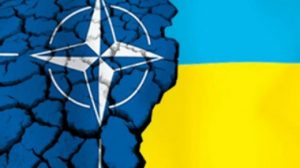
The premise that NATO is no longer justified as a military apparatus
was unthinkable. As the Soviet Union ceased to exist, there was euphoria
in Washington. To understand the mood of those guarding the American
power in 1990, it is worth reading the work of a political commentator
and proud American imperialist, Charles Krauthammer,
who declared “The Unipolar Moment” in an essay for the Foreign Affairs
magazine. Indeed, the United States was now the only global empire.
“American preeminence,” Krauthammer points out, “is based
on the fact that it is the only country with the military, diplomatic,
political and economic assets to be a decisive player in any conflict in
whatever part of the world it chooses to involve itself.”
To maintain such a status quo, it is important not to regard
“America’s” military “exertions abroad as nothing but a drain on its
economy.” The defense spending is indeed vital for the empire. In this
context, the relationship within the North Atlantic Treaty Organization
can be summarized as following: there is “the United States and behind
it the West, because where the United States does not tread, the
alliance does not follow.”
The post-Cold War decades have demonstrated that Krauthammer’s
extreme far-right judgment represents an overarching establishment view
on the strategy of American foreign policy.
Employing its “military, diplomatic, political and economic”
supremacy, the United States has aggressively been pursuing its imperial
objectives in Eastern Europe, spearheading the expansion of NATO and
influencing political processes in countries such as Ukraine and
Georgia. The case of Ukraine is particularly revealing, as the events
there have been used to justify the militarization of Eastern Europe.
Indeed, the West never hid its support for the protests that took place
on Kiev’s Maidan Square between November 2013 and February 2014.
“Since Ukraine’s independence in 1991,” emphasized the Assistant Secretary Victoria Nuland,
“the United States has supported Ukrainians,” investing “over five
billion dollars” to make an impact on their political and economic
structure.
The investment was a success; Ukrainian freedom, as that is how it
was conventionally described, was achieved in an undemocratic coup
against the elected President Viktor Yanukovych. Coming on his place was the establishment of the current President, Petro Poroshenko, a neoliberal pseudo-fascist and a solid choice for Washington. In 2006, Poroshenko was described in the U.S. diplomatic cable
as “our Ukrainian insider.” Turned President, the “Ukrainian insider”
drifted the country towards Washington’s consensus, implementing the
grotesque package of IMF-drafted economic reforms and welcomed hundreds
of Western military advisers on Ukrainian soil. The military advisers
are there for a reason: they are training the army to wage war against
Russian-speaking secessionists in the Eastern Donbass region, in a
conflict that has left over 10,000 people dead and over one million
displaced. Admittedly, one would be called mad to claim that there would
be war in Ukraine before a Western-backed coup.
Russian has been responding to the developments in Ukraine. There is
no doubt that it is providing material support to the rebels in Donbass.
President Putin, in fact, has inexplicitly pointed
to this while assuring reporters that “the self-proclaimed Republics
have enough weapons” to fight against the Ukrainian army. Moscow’s
response to the conflict in Donbass, however, strikingly differs from
its initial response to the coup, symbolized by its reactionary
annexation of the Crimean Peninsula. The reason for that was never a
guarded secret. While it is true that most people in Crimea supported
unification with Russia, the Kremlin’s rapid decision on the matter had
perhaps less to do with the fact that the Crimean population consists of
a Russian majority, and more to do with the presence of Russia’s
historic Black Sea naval base in Sevastopol. Speaking for Oliver Stone’s
documentary film Ukraine on Fire, President Putin summarized the importance of a military base in Crimea for the following reason:
“The base, per us, doesn’t mean anything, but there is a
nuance I would like to point out. Why do we react so vehemently to
NATO’s expansion? We are concerned with the decision-making process. I
know how decisions are made. As soon as the country becomes a member of
NATO, it can’t resist the pressure of the U.S. And very soon anything at
all can appear in such country – missile defense systems, new bases or,
if necessary, new missile strike systems. What should we do? We need to
take countermeasures.”
Of course, it is possible to make a case that Ukraine is not a member
of NATO. In fact, there seems to be no enthusiasm within the alliance
about the prospect of Ukraine’s membership. While for the establishment in Kiev, “membership” in NATO is a “strategic goal,” the former U.S. ambassador to Ukraine, John E. Herbst, stated that this goal will not be fulfilled anytime soon. The European NATO members “are anxious about provoking Moscow,” he says.
This does not mean, however, that Ukraine cannot be used as a
satellite member of the alliance. Without a formal membership, the
“Ukrainian insider[s]” of Washington have permitted the West to maintain
a military contingent in the country, for example, allowing its naval ships
to enter the Black Sea port in Odessa. If Crimea remained a part of
Ukraine, it is somewhat plausible that Kiev would have hosted these NATO
ships on the peninsula. Perhaps this answers why the annexation caused
such an outcry from the West.
Amidst the developments discussed above, Russia’s defense policy can
indeed be viewed as a response to NATO’s provocative expansionism and
Washington’s zealous pursuit to maintain its “unipolar moment.” This
unilateralist position has empowered “the conservative forces” in
Russia, who are preserving and enhancing the country’s defense
capabilities.
Tensions between the two sides are consequently rising; nuclear war is unthinkable no more.
An Irresponsible Global Player

Raising the stakes following Putin’s address was, again, the United
States. The response to Russia was delivered by the Commander of the
United States Strategic Command (STRATCOM), John Hyten (image on the left). Speaking before the House Armed Services Committee, Hyten carried a message
that should frighten anyone concerned about the long-term survival of
mankind. “We are ready for all the threats that are out there and no
one, no one should doubt this,” stated the General. Continuing from that
note, Hyten reassured the committee about America’s preparedness to
obliterate Russia:
“By the way, our submarines, they [the Russians] do not
know where they are, and they have the ability to decimate their country
if we go down that path.”
In Russia, Hyten’s remarks were featured in a news segment with the following question: is “American pursuing global suicide?”
Washington’s war rhetoric is not novel. While being the only country
to use nuclear weapons in war, the United States has repeatedly been
threatening to destroy the societies it perceives as its strategic
“adversaries.” In an interview
on ABC’s Good Morning America in 2008, then-presidential candidate
Hillary Clinton emphasized that the U.S. can “totally obliterate” Iran.
Clinton’s message was replicated in 2017 by President Trump, though the
threats were now directed against a different country. Speaking before
the General Assembly of the United Nations, Trump announced to the whole
world that Washington is prepared to “totally destroy North Korea.”
Admittedly, there is a serious debate in Washington about employing
what they call the “bloody nose policy” against Pyongyang. The total
destruction will be inflicted by a “preventive war”, promoted by Trump’s
former National Security Adviser, Herbert McMaster, and the incumbent neocon John Bolton. Agreeing with their stance is Henry Kissinger, the National Security Adviser under President Nixon. Testifying before the Senate Armed Services Committee, Kissinger points
out that “The temptation to deal with” North Korea “with a pre-emptive
attack is strong and the argument is rational.” This is madness. The
“rational” argument advocates for a nuclear war and genocide. The North
Korean side, moreover, has repeatedly requested for peace negotiations –
all rejected by Washington.
Unsurprisingly, however, the “bloody nose policy” was not received
well by the American public, amidst the ongoing propaganda campaign
about the North Korean threat.
To reverse the words of the U.S. State Department spokesperson, this
can’t be regarded “as the behavior of a responsible international
player.” While purposely escalating tensions, the United States is
driving the world towards war.
Public Opinion vs. Power
The growing threat of war is measured fairly by the Doomsday Clock.
Developed and updated by the Bulletin of Atomic Scientists, since 1947,
the clock measures the proximity of a catastrophe that will endanger, if
not extinguish, the conditions for an organized existence of human
beings on Earth. When America and Soviet Union enabled the
Anti-Ballistic Missile Treaty, the doomsday clock
was set at 12 minutes before the midnight, a point of the hypothetical
global disaster. The threat was at its lowest – 17 minutes before the
midnight – when the Soviet Union collapsed in 1991. Since then, however,
the instability in the world caused by Washington’s desire to retain a
unipolar supremacy has increased the risks dramatically. For the year
2018, the clock was set at 2 minutes before midnight. Today, humanity is
as close to a catastrophe as it was at the height of the Cold War in
1953.
Operating within the structure of power, ignoring this danger, and
perpetuating the status quo that brought us to this point, indeed, is
equivalent of committing a crime against humanity. The contemporary
rivalry between two nuclear powers can’t be logically justified.
If the leaders of both countries are genuinely concerned about
defending the interests of their citizens, then it should be their
priority to diffuse friction. Interestingly, while enhancing its defense
policy, Russia, still, seems to show greater eagerness for detente than
Washington and NATO. In his interview with the Russian leader, Oliver
Stone asked why Putin persistently refers to the West as “our partners.”
The answer was immediate: the “dialogue has to be pursued further.”
It is, moreover, safe to judge that most people in the world do not regard nuclear weapons as a guarantor of peace. Within the domestic realm of the American empire, 77 percent of people favor elimination of all nuclear weapons. An important message was also delivery
by the United Nations General Assembly vote for the resolution L.41, a
“legally binding instrument to prohibit nuclear weapons, leading towards
their total elimination.” In the 2016, as many as 123 countries,
including North Korea, voted in favor of the resolution. Only 39 voted
against. Unsurprisingly, the major nuclear powers were among them.
Interesting, nonetheless, is the behavior of small NATO states in
Eastern Europe: many of them, too, voted for the doctrine of those
leading the world towards destruction.
Eliminating the risk, as well as changing the status quo of
unilateral extremism and imperialism, is not an impossible task. For
they attain enough political influence, the citizens of the empire have
always posed a threat to the imperial structure. As a proud
imperialist, Krauthammer understood this threat and summarized it in the
following way:
“Can America support its unipolar status? Yes. But will
Americans support such unipolar status? That is a more problematic
question. For a small but growing chorus of Americans this vision of a
unipolar world led by a dynamic America is a nightmare.”
He is right.
*
|
|
Disclaimer: The contents of this article are of sole
responsibility of the author(s). The Centre for Research on
Globalization will not be responsible for any inaccurate or incorrect
statement in this article.
|
|
|
|
